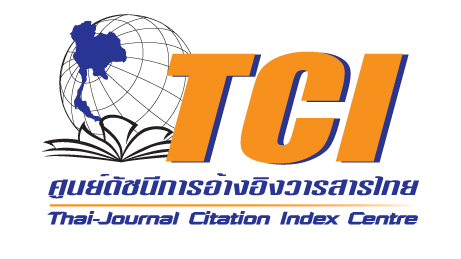The Influence of Financial Distress on Tax Planning Among Listed Companies in the Three Industries with Highest Investment Promotion Applications to Thailand Board of Investment in 2023
DOI:
https://doi.org/10.14456/ajmt.2025.4Keywords:
Tax Planning, Financial Distress, Listed Companies in the Stock Exchange of ThailandAbstract
This research aims to study the level of financial distress, compare the tax planning of listed companies in the three industries with highest investment promotion applications to Thailand Board of Investment (BOI) in 2023, namely the Technology Industry, Industrial Products, and Agriculture and Food Industry, and analyze the influence of financial distress on tax planning of these companies. The population of the study was 217 companies, with 160 companies selected through purposive sampling. Statistical methods employed include One Sample T-test, Levene’s test, One-Way ANOVA, and Multiple Regression Analysis. The results revealed that companies in all three industries experienced high levels of financial distress. The effective tax rates resulting from tax planning did not differ significantly across industries but were significantly lower than statutory tax rates. Furthermore, financial distress exhibited a positive influence on tax planning, indicating that companies with higher financial distress tend to engage in more extensive tax planning. Government agencies can use these findings to formulate tax policies that promote investment in target industries during economic downturns.
References
Abdu, E. (2022). Financial distress situation of financial sectors in Ethiopia: A review paper. Cogent Economics & Finance, 10(1), 1-13. https://doi.org/10.1080/23322039.2021.1996020
Alharbi, S., Atawnah, N., Al Mamun, M., & Ali, M. J. (2022). Local culture and tax avoidance: Evidence from gambling preference behavior. Global Finance Journal, 52(100585). https://doi.org/10.1016/j.gfj.2020.100585
Altman, E., I., Hartzell, J., & Peck, M. (1995). Emerging market corporate bonds: A scoring system. Salomon Brother.
Altman, E. I. (1968). Financial ratios, discriminant analysis and the prediction of corporate bankruptcy. The Journal of Finance, 23(4), 589-609. https://doi.org/10.2307/2978933
Alfarasi, R., & Muid, D. (2022). Pengaruh financial distress, konservatisme, dan sales growth terhadap tax avoidance perusahaan (Studi mmpiris pada perusahaan makanan dan minuman yang terdaftar di BEI Periode 2017-2019). Diponegoro Journal of Accounting,11(1), 1-10. https://ejournal3.undip.ac.id/index.php/accounting/article/view/33067
Angelina, S., & Darmawan, A. (2021). The impact of tax planning on firm value. Journal of Applied Accounting and Taxation, 6(2), 196-204. https://doi.org/10.30871/jaat.v6i2.3522
Ariff, A., Ismail, W. A. W., Kamarudin, K. A., & Suffian, M. T. M. (2022). Financial distress and tax avoidance: the moderating effect of the COVID-19 pandemic. Asian Journal of Accounting, 8(3). https://doi.org/10.1108/AJAR-10-2022-0347
Bank of Thailand. (2022). Policy Normalization (in Thai). BOT Magazine, (3), 30-37. https://shorturl.asia/oxQMl
Beaver, W. H. (1966). Financial ratios as predictors of failure. Journal of Accounting Research, 4, 71-111. https://doi.org/10.2307/2490171
Brondolo, J. (2009). Collecting taxes during an economic crisis: challenges and policy options. IMF staff position note SPN/09/17, (pp.1-38). www.imf.org/external/p stock exchange of Thailand ubs/ft/spn/2009/spn0917.pdf
Chaiyasit, T. (2024). Tax planning (8th ed.). Winyutchon.
Chotsuwan, R. (2019). The relationship between tax planning and stock price of listed companies in the Stock Exchange of Thailand (SET). RMUTT Global Business and Economics Review, 14(1), 23-36. https://so03.tci-thaijo.org/index.php/RMUTT-Gber/article/view/241348
Coakes, S. J., & Steed, L. G. (2003). SPSS analysis without anguish version 11 for Windows. John Wiley and Sons Australia Limited.
Dang, V. C., & Tran, X. H. (2021). The impact of financial distress on tax avoidance: An empirical analysis of the Vietnamese listed companies. Cogent Business & Management, 8(1), 1-10. https://doi.org/10.1080/23311975.2021.1953678
Derashid, C., & Zhang, H. (2003). Effective tax rates and the "industry policy" hypothesis: evidence from Malasis. Journal of International Accounting, Auditing and Taxation, 12(1), 45-62. https://doi.org/10.1016/S1061-9518(03)00003-X
Desai, M., & Dharmapala, D. (2006). Corporate tax avoidance and high-powered incentives. Journal of Financial Economics, 79(1), 145-179. https://doi.org/10.1016/j.jfineco.2005.02.002
Dyreng, S., Hanlon, M., & Maydew, E. (2008). Long-run corporate tax avoidance. The Accounting Review, 83(1), 61-82. https://www.jstor.org/stable/30243511
Edwards, A., Schwab, C. M., & Shevlin, T. J. (2013). Financial constraints and the incentive for tax planning. 2013 American Taxation Association Midyear Meeting: New Faculty/ Doctoral Student Session. https://ssrn.com/abstract=2216875
Industrial Economics Office. (2024). Industrial economic report. https://km.fti.or.th/wp-content/uploads/2024/01/รายงานภาวะเศรษฐกิจอุตสาหกรรม.pdf
James, G., Witten, D., Hastie, T., & Tibshirani, R. (2013). An introduction to statistical learning, 112. https://doi.org/10.1007/978-1-4614-7138-7
Jensen, C., & Mecking, H. (1976). Theory of the firm: Managerial behavior, agency costs and ownership structure. Jounal of Financial Econonmics 3(4), 305-360. https://doi.org/10.1016/0304-405X(76)90026-X
Khuong, N. V., Liem, N. T., Thu, P. A., & Khanh, T. H. T. (2020). Does corporate tax avoidance explain firm performance? Evidence from an emerging economy. Cogent Business & Management, 7(1), 1-17. https://doi.org/10.1080/23311975.2020.1780101
Kleinbaum, D. G., Kupper, L. L., Nizam, A., & Rosenberg, E. S. (2014). Applied regression analysis and other multivariable methods. Cengage Learning.
Kline, R. B. (2011). Principles and practice of structural equation modeling. Guilford Press.
Kouroub, S., & Oubdi, L. (2022). Tax planning: theory and modeling. Journal of Applied Business, Taxation and Economics, 1(6), 594-613. https://doi.org/10.54408/jabter.v1i6.100
Kulvijit, T., & Yangklan, P. (2024). Factors of capital structure and working capital management that affect profitability of companies in the property and construction industry listed in the Stock Exchange of Thailand. Academic Journal of Management Technology, 5(2), 1-14. https://doi.org/10.14456/ajmt.2024.10
Lanis, R., & Richardson, G. (2011). The effect of board of director composition on corporate tax aggressiveness. Journal of Accounting and Public Policy, 30(1), 50-70. https://doi.org/10.1016/j.jaccpubpol.2010.09.003
Lapprasertlam, P. (2022). Approaches to the collection of wealth tax in Thailand. [Unpublished Master's Thesis]. Chulalongkorn University.
https://digital.car.chula.ac.th/cgi/viewcontent.cgi?article=9240&context=chulaetd
Lim-u-sanno, K. (2022). The influence of tax planning on earnings management of Thai stock exchange. Journal of Social Science and Buddhistic Anthropology, 7(5), 99-111.
https://so04.tci-thaijo.org/index.php/JSBA/article/view/254090
Mahmud, N. M., Kamaruddin, N. N. A. N., Adam, A., Raman, S. A., & Shaari, S. N. M. (2022). The influence of the industrial sector and reviewed corporate governance code on tax avoidance practices in Malaysia. International Journal of Academic Research in Accounting Finance and Management Sciences, 12(3), 419–429.
Maulana. (2018). The effect of transfer pricing, capital intensity and financial distress on tax avoidance with firm size as moderating variables. Modern Economics, 11(10). https://doi.org/10.31521/modecon.V11(2018)-20
Merton, R. C. (1974). On the pricing of corporate debt: the risk structure of interest rates. The Journal of Finance, 29(2), 449-470. https://doi.org/10.2307/2978814
Nopphaisit, N., & Likitwongkajon, N. (2019). Financial distress prediction through the combination of cash flow components of listed companies in the Stock Exchange of Thailand. Nida Business Journal, 25, 26-50. https://so10.tcithaijo.org/index.php/NIDABJ/article/view/373
Noor, R. M., Fadzillah, N. S. M., & Mastuki, N. (2010). Tax planning and corporate effective tax rates. In 2010 International Conference on Science and Social Research (CSSR 2010) (pp. 1238-1242). IEEE Explore. https://doi.org/10.1109/CSSR.2010.5773726.
Office of the Permanent Secretary, Ministry of Finance. (2024). Disclosure information of the Ministry of Finance (in Thai). https://dataservices.mof.go.th/menu3?id=2
Pastena, V., & Ruland, W. (1986). The merger/bankruptcy alternative. The Accounting Review, 61(2), 288–301. https://www.jstor.org/stable/247259
Richardson, G., Taylor, G., & Lanis, R. (2015). The impact of financial distress on corporate tax avoidance spanning the global financial crisis: Evidence from Australia. Economic Modelling, 44, 44-53. https://doi.org/10.1016/j.econmod.2014.09.015
Sadjiarto, A., Hartanto, S., Natalia, & Octaviana, S. (2020). Analysis of the effect of business strategy and financial distress on tax avoidance. The Asian Institute of Research, 3(1), 238-246. https://doi.org/10.31014/aior.1992.03.01.193
Schwab, C. M., Stomberg, B., & Williams, B. M. (2022). Effective tax planning. The Accounting Review, 97(1), 413-437. https://doi.org/10.2308/TAR-2019-0020
Sirot, B. S., Arum, E. D. P., & Wiralestari. (2024). The effect of financial distress, and earnings management On tax avoidance. Prosiding Simposium Ilmiah Akuntansi, 1(1), 909-925. https://sia-iaikpd.fdaptsu.org/index.php/sia/article/view/29
Soleimani Amiri, G. R. (2003). Efficiency evaluation of financial crisis forecast forms for Iranian Companies. Journal of Accounting Knowledge, 2, 139-158.
Springate, G. L. V. (1978). Predicting the possibility of failure in a canadian firm. [Unpublished Master's Thesis]. Simon Fraser University.
Tantiyavarong, T. (2009). A study of the determinants of tax planning and the association between tax planning and firm value: an empirical evidence of Thailand. [Unpublished Doctoral dissertation]. Chulalongkorn University.
Thanjunpong, S., & Dechsiri, P. (2018). The causal effect of tax planning on firms' performance of listed companies in Thailand. University of the Thai Chamber of Commerce Journal Humanities and Social Sciences, 38(3), 1-13. https://so06.tcithaijo.org/index.php/utccjournalhs/article/view/157959
Thansettakij. (2024). The Revenue Department is confident in meeting its tax collection target of 2.27 trillion, attracting businesses to join the system (in Thai). https://www.thansettakij.com/business/economy/601762
The Stock Exchange of Thailand. (n.d.). Industry classification and business categories (in Thai). https://www.set.or.th/th/listing/equities/industry-sector-classification
The Investor Club Association. (2024). News from BOI: Promoting investment in 2023 surged to over 800 billion. BOI unveils 5 plans to attract investment in 2024 (in Thai). https://shorturl.asia/EOWFi
Tilehnouei, M. H., Esfahani, S. T., & Soltanipanah, S. (2018). Investigating the effect of financial distress on tax avoidance during the global financial crisis in companies listed on tehran stock exchange. International Journal of Finance and Managerial Accounting, 3(9). https://shorturl.asia/k3mwl
Wenwu X, Khurram M. U., Qing L., & Rafiq, A. (2023). Management equity incentives and corporate tax avoidance: Moderating role of the internal control. Frontiers in Psychology. 14(1096674), 1-13. https://doi.org/10.3389/fpsyg.2023.1096674
Zimmerman, J. (1983). Taxes and firm size. Journal of Accounting and Economics, 5(2), 119-149. https://doi.org/10.1016/0165-4101(83)90008-3
Downloads
Published
How to Cite
Issue
Section
License
Copyright (c) 2025 Faculty of Management Technology, Rajamangala University of Technology Isan Surin Campus

This work is licensed under a Creative Commons Attribution-NonCommercial-NoDerivatives 4.0 International License.
บทความที่ได้รับการตีพิมพ์เป็นลิขสิทธิ์ของคณะเทคโนโลยีการจัดการ มหาวิทยาลัยเทคโนโลยีราชมงคลอีสาน วิทยาเขตสุรินทร์
ข้อความที่ปรากฏในบทความแต่ละเรื่องในวารสารวิชาการเล่มนี้ เป็นความคิดเห็นส่วนตัวของผู้เขียนแต่ละท่านไม่เกี่ยวข้องกับคณะเทคโนโลยีการจัดการ มหาวิทยาลัยเทคโนโลยีราชมงคลอีสาน วิทยาเขตสุรินทร์ และคณาจารย์ท่านอื่นๆในมหาวิทยาลัยฯ แต่อย่างใด ความรับผิดชอบองค์ประกอบทั้งหมดของบทความแต่ละเรื่องเป็นของผู้เขียนแต่ละท่าน หากมีความผิดพลาดใดๆ ผู้เขียนแต่ละท่านจะรับผิดชอบบทความของตนเองแต่ผู้เดียว











